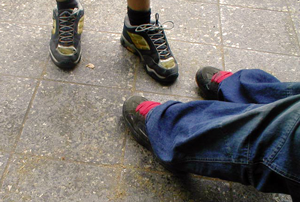Last month, I began to outline new directions in my postdoctoral research agenda that would bring together my research on systems integration in the homelessness sector with my new research on community safety. This week, I learned that one the 16-year old youth I hired this summer as a youth researcher for the project on community safety is couch-surfing. I’ve been worried about housing insecurity for this particular young man – let’s call him Marlin – for some time now.
Marlin lives in Toronto Community Housing (TCH) with his mom, siblings, and his mother’s new boyfriend. A few years ago he and his family were moved by TCH from Scarborough to Jane and Finch. After moving, he did not attend school in his new neighbourhood for two years. Although he describes the problem as political (“I have beefs with people here”), I think Marlin was afraid. Anyone who knows anything about “the politics of the ‘hood” knows that this East to West would have been a difficult move for him – the unspoken rules and norms of the streets here wouldn’t be immediately obvious to Marlin, and he could have easily and unwittingly transgressed them. I will admit that this is something I’ve had to learn from the youth we’ve been working with. Most days, I feel like Jon Snow beyond the Wall: “You know nothing …” My experience working with our team of youth researchers over the last seven weeks is that “politics” and “beefs,” make them unwilling to go into many of the ‘hoods in Jane and Finch except their own.
Eventually Marlin got involved with the justice system, and spent some time at the Roy McMurty Youth Centre. Although he was a first-time offender, he ended up staying for 30 days, being moved from Intake to the Ranges in the jail because his mom wouldn’t post bail for him. With a minor charge like the one Marlin received, in order to post bail, his mom simply had to state that she was willing to be responsible for him and have him come home. But conflicts between the two of them preceded his charge, and she was not willing to have him home right away. When he was eventually released into his mother’s custody, it was without any support for the resolution of the conflicts brewing between the two of them. In fact, from Marlin’s point of view, the time at “the Roy” simply intensified the conflict between the two of them. When we spoke about this time in his life, he explained that he was hurt and angry by his mom’s reluctance to post bail. Trouble between the two of them continued to brew. Marlin has another brush with the law, and continued difficulty with school.
Throughout this summer, Marlin and his mom were often having difficulty. Many times, he’d come in to work having not slept much the night before. I knew from other interviews that trouble with the “dukes” (i.e., family) resulted in some young people crashing with friends or relatives, sleeping in stairwells, or “trap-“ (i.e., crack) houses for a night or two until the dust settled at home. I suspected that something like this might be happening with Marlin. But when I asked him if he was ever sleeping “out,” he assured me that he wasn’t. Even though things would escalate between he and his mom, he’d always end up back in his own bed at some point in the night. Yesterday we learned that his mom has kicked him out.
This is the point where a coordinated and preventative response to youth homelessness could make all the difference. Marlin would like to return home. But things between him and his mother have escalated to violence. A successful diversion for Marlin, could involve respite and other supports for his mother coupled with conflict mediation for the two of them. Without any intervention, however, it is likely that Marlin’s will continue to experience housing instability.
Sometimes couch-surfing is described as hidden homelessness because the individual doesn’t use shelter services and may not touch the homelessness system at all. But Marlin’s homelessness won’t stay hidden for long. Eventually he will stay out his welcome with friends or be asked to pay rent. Our summer research program has ended. We’ve connected Marlin to another participatory action research project taking place in Jane and Finch, but he is likely to need more money than this work will bring. At this point, his options are limited. Ontario Works is insufficient to cover the costs of housing in Toronto. Marlin has received very few high school credits to date, and needs considerable one-on-one support to stay on task. Further, youth in Jane and Finch have difficulty accessing employment – particularly those like Marlin who are involved in the justice system and need time off work to meet with probation officers and go to court. Further, Marlin has needed a lot of patience and support from our team to keep him meaningfully engaged in our project all summer. We committed to doing this work when we hired him. Others will be unlikely to make this commitment, and Marlin will be unlikely to maintain his employment.
Although I’ve glossed over many important details, Marlin’s story illustrates some of the interplay between housing and homelessness, education, youth justice, family dynamics, and community safety. If we really are committed to creating and maintaining safe and healthy communities, we need to think about how all the pieces of the puzzle fit together in order to ensure that Marlin and his family are meaningfully supported by, and included in, the broader community.


